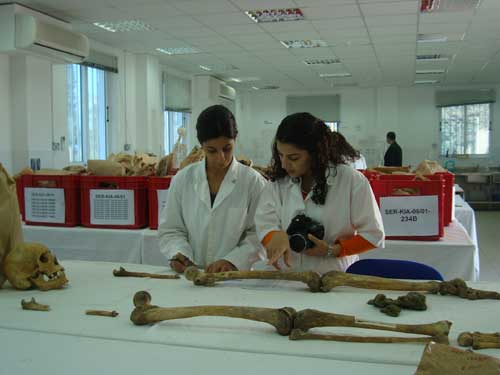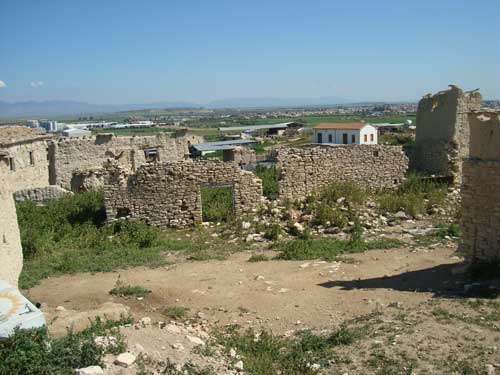The living dead of the Cyprus tragedy
ASCENDING the hill on the way to the Nicosia International Airport, the landscape is so beautiful it looks good enough to eat. After five years of drought, the heavens have opened up, filling the fields with wildflowers straddling the edge of the road, right up to the tarmac road.
We are in the buffer zone separating the free from the occupied areas of the island. The land here is virtually untouched. So too the old international airport, which since 1974 has been bereft of travellers, its facilities now housing the UNFICYP headquarters.

Inside a complex of makeshift offices, just before reaching the passenger terminal, we find the Anthropological Laboratory of the Committee on Missing Persons (CMP). We took a tour of the CMP, learning about the work being done there by a team of Greek and Turkish Cypriot archaeologists, anthropologists, geneticists and technocrats, all working together to give closure to the humanitarian issue of the missing persons.
Stacked in an orderly fashion inside an air-conditioned room are dozens of red boxes filled with human remains. Crammed within these boxes is the unwritten history of the Cyprus problem. Each of the remains tells its own story:
- A National Guardsman killed during the war and hastily buried in Kyrenia.
- A child executed in cold blood by fanatics of the Turkish Cypriot organisation TMT in 1974.
- A Turkish Cypriot abducted by Greek Cypriot nationalists in 1964, thrown down a well and left to rot there for almost half a century
The missing persons are the most tragic aspect of the Cyprus problem. It is one thing for a family to grieve for a young man killed in the war, to bury him, and perhaps move on with their lives, his fiancée or wife remarrying; it is quite another to wait for him to return from the prisons of Turkey.
For 30 years the missing persons issue was the steam engine of political propaganda. The missing were the living dead of the Cypriot tragedy. During the first few years after 1974, black-clad mothers were a prominent fixture of political gatherings and rallies, as politicians vowed to bring their sons back alive.
As recently as 1990, journalists would dream up stories about missing persons being spotted in Turkish prisons. One Athens-based newspaper once ran a front-page story claiming that missing Greek Cypriot youths were being sent as Janissaries to fight in Afghanistan. And a few years ago, a Nicosia-based paper reported that the missing were being used as guinea pigs in chemical warfare plants in Turkey.
The facts were far more mundane, it turned out: some of the persons presumed to be missing had been killed in action, others remained unburied in the Pentadaktylos mountains, some were kidnapped and executed in cold blood by Turks and Turkish Cypriot fanatics, and others still were buried in the government-controlled areas of Cyprus but had not been identified as such.
The outlandish theories have since faded, and political expediency has lost its sense of direction. Today, the afterword on the tragedy is being written at the CMP’s anthropological laboratory in Nicosia.
It has taken 30-odd years for the humanitarian aspect to prevail over politics, paving the way for the exhumations and identifications that are currently under way. Initiated unilaterally by the government, with the Turkish Cypriot side coming on board at a later date, the project involves seeking and gathering information about missing persons, exhuming and identifying their remains and handing them to relatives so the deceased may receive a proper burial according to their religion.
Facts and figures
– Initially the number of Greek Cypriot missing persons was thought to be 2,500, later dropping to 2,000 and then to 1,619. The latter number was standardised, becoming a symbol for two decades.
– Currently, the official number of the Greek Cypriot missing is reported as 1,468, although the CMP has been asked to track down only 1,340 of these.
– The Turkish Cypriots have registered 502 missing persons, who either disappeared in the period 1963-1964 (about 300 individuals) or were murdered in 1974.
– Since 2004, when the exhumations began, the tragedy of Cyprus has unfurled slowly, emerging from the group graves and the wells. So far the CMP has excavated 252 sites and discovered the remains of 510 persons. Of these, 136 have been identified through DNA identification and handed over to the relatives.
Today, the Greeks and Turks of Cyprus – combatants killed in action or innocent civilians murdered by nationalists of either community – lie dead, side by side on the workbenches of the CMP laboratory, waiting to be recognised.
Rezan seeks the identity of Andreas, Eleni seeks the identity of Mehmet. You can’t tell whether a skull belongs to a Greek or a Turkish Cypriot any more than you can tell whether this or that anthropologist in their white work shirts is a Greek or a Turk. The boxes containing human remains are code-labelled according to the excavation site. Drawing on their scientific expertise, anthropologists try to piece together the human skeletons and use DNA identification. Once this is done, the relatives are contacted and handed the remains, so that they may properly bury their loved ones 35 or 45 years after the fact.

Petrofani
At the moment, exhumation work is being carried out at four sites across the island. We visited a team of scientists working in a Turkish Cypriot village straddling the buffer zone, about 30 km from Nicosia.
Called Petrofani, in 1974 this village had a population of around 100, all of them Turkish Cypriots. In the wake of the Turkish invasion, the residents were relocated to the nearest Turkish Cypriot enclave for their safety. All left, except for six elderly people who stayed behind, wishing to live out their lives in their native village.
On July 20 the village was stormed by a group of nationalists, who kidnapped the inhabitants – one of whom was wheelchair-bound – murdered them and threw the corpses down a dry well.
A number of wells can be found in the area, which is predominantly pastureland. Although information on what happened here was reliable, no one had been able to pinpoint the dry well in question.
Efforts began in 2006, and in total 11 wells were investigated but without success. Finally, the six people were found in a twelfth well, their remains interspersed with the bones of animals, whose carcasses were dumped in the wells by local shepherds.
During the ensuing exhumation, scientists discovered that part of the skeletal remains were missing, so they began sifting through the soil, much like archaeologists do. The scientists were keen to recover all of the remains so that they could be returned to the deceased’s relatives as intact as possible.
The village of Petrofani commands the hill overlooking the group grave. Long abandoned by its inhabitants, today it is in ruin – just like Cyprus’ history is in tatters. Barely standing homes have been turned into stables for sheep. In fact, the entire village is one large barn.
Archaeologist Margarita Kouali, in charge of the exhumation work here, left her crew for a while to give us a tour of the village, or what remains of it. Just one building still stands intact, a school built of stone. All the other adobe houses were looted initially, the passage of time dealing them the final blow and reducing them to ruins.
Kouali hails from cosmopolitan Limassol. Growing up, the only connection she had ever had with the Cyprus problem was the “Never Forget” class in school. She had never even heard of Turkish Cypriot missing persons. It was only when she went to work as an archaeologist for the CMP that her path crossed with the history of Cyprus.
“It doesn’t matter whether the remains we exhume belong to a Greek or a Turkish Cypriot; the feeling is the same,” she says. “We’ve come to know the real tragedy of Cyprus and to understand people’s grief: a grief that has no ethnicity.”
Gulseren Varanan, another archaeologist, crosses daily from the occupied areas to come to work. “Our collaboration with the Greek Cypriot colleagues is excellent. We leave the politics out of it and focus on the task at hand,” she tells us.
Gazing down from the hill on which Petrofani is situated, the buffer zone looks gorgeous. If one good thing has come out of the present situation, it is that the buffer zone has been spared the ravages of development.
In reality, this ‘dead zone’, is teeming with colours and very much alive. Yet its every inch hides a tragedy. The people who died in vain here haunt the Cyprus problem, making it all the trickier to solve.
By piecing together the debris left by the actions of the previous generation, this team of young archaeologists, anthropologists and geneticists hope to cast out the demons of our past, so that Cyprus can once again become a united country.
Makarios Drousiotis
Cyprus Mail
10/05/2009